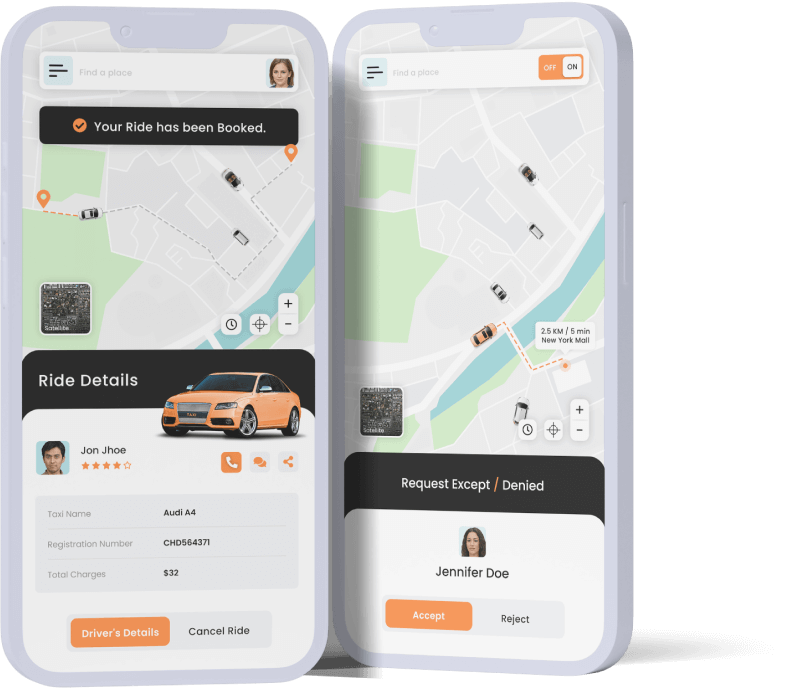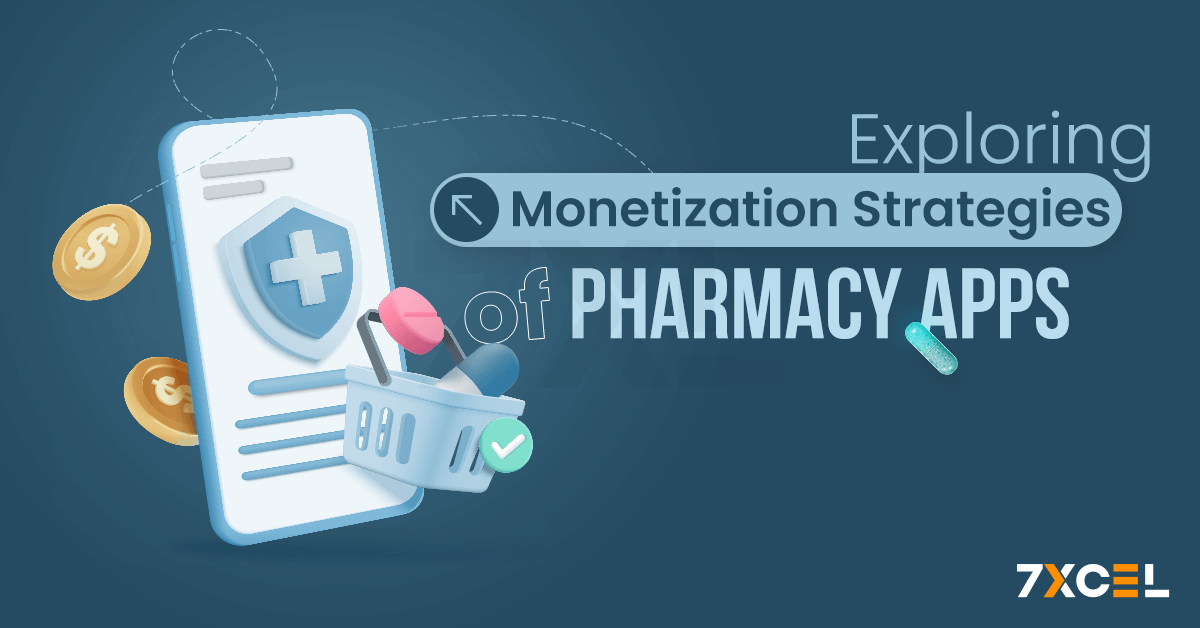Quick Summary:
Developing a taxi app involves careful planning and execution to ensure market success and user satisfaction. This guide covers crucial steps such as market research, feature definition, technology selection, UI/UX design, development, testing, launch, and ongoing maintenance. By following these steps, you can create a robust, user-friendly taxi app that meets market needs and achieves long-term profitability.
The on-demand transportation industry has been transformed by the rise of innovative taxi booking apps, offering convenience, reliability, and affordability. With the growing demand for these apps, businesses are eager to tap into this lucrative market. Developing a successful taxi booking app requires a methodical approach, addressing industry-specific challenges and focusing on features, user experience, and monetization.
This guide outlines the essential steps for creating a competitive and profitable taxi app, covering everything from market research and feature design to development, payment integration, testing, and ongoing optimization.
Creating a Taxi Booking App: Essential Steps
Building a taxi booking app involves planning, market research, design, development, and deployment. Partnering with a specialized Taxi Booking App Development Company can streamline this process, ensuring that each step is executed with precision.
Their expertise can help in creating a user-friendly and efficient app, incorporating key features like real-time tracking, dynamic pricing, and secure payment gateways. This guide outlines essential steps to create a seamless experience for both users and service providers, setting the app up for success in a competitive market.

1. Market Research and Conceptualization
The first step in developing a successful taxi app is conducting thorough market research and conceptualizing a unique and viable idea. Understanding the market landscape, competition, and user needs is crucial for creating a compelling product.
Steps:
- Identify Market Needs: Analyze the current market to identify gaps and unmet needs. Look for opportunities to offer unique features or better services than existing competitors.
- Understand Competitors: Study successful taxi apps like Uber and Lyft to understand their strengths and weaknesses. Identify areas where you can differentiate your app.
- Define Target Audience: Determine who your potential users are, such as urban commuters, tourists, or corporate clients. Tailor your app’s features and marketing strategy to meet their specific needs.
- Concept Development: Brainstorm and outline your app’s key features and functionalities. Consider aspects like user interface design, booking options, and payment methods.
Deliverables:
- Market analysis report
- Competitor analysis
- User personas
- Initial concept and feature list
2. Define Features and Functionality
Defining the features and functionalities of your taxi app development is crucial for ensuring it meets user expectations and stands out in the market. Consider both the passenger and driver sides of the app.
Steps:
- Essential Features:
- Passenger App: User registration, ride booking, fare calculation, real-time tracking, payment options, ride history, ratings and reviews.
- Driver App: Driver registration, ride requests, navigation, earnings tracking, ratings and reviews, communication with passengers.
- Advanced Features:
- Admin Panel: A centralized dashboard for managing users, drivers, payments, and analytics.
- Real-Time Analytics: Tools for tracking app performance and user engagement.
- Push Notifications: For ride updates, promotions, and reminders.
- Loyalty Programs: Incentives for regular users, such as discounts or reward points.
- Future Features:
- Integration with Public Transport: Options for multimodal travel.
- AI-Powered Recommendations: Personalized suggestions based on user preferences and behavior.
- Voice Commands: For hands-free app navigation and booking.
Deliverables:
- Detailed feature list
- Functional requirements document
- User flow diagrams for passenger and driver apps
3. Choose the Right Technology Stack
Selecting the appropriate technology stack is vital for the app’s performance, scalability, and future growth. Consider the front-end and back-end technologies, as well as platform-specific requirements.
Steps:
- Front-End Development: Based on your target audience and budget, decide between cross-platform (React Native, Flutter) and native (Swift for iOS, Kotlin for Android) development.
- Back-End Development: Select a robust framework for server-side development, such as Node.js, Ruby on Rails, or Django. Ensure it supports high performance and scalability.
- Database: When handling massive amounts of data, go for scalable database solutions like PostgreSQL or MongoDB.
- APIs and Integrations: Use APIs for functionalities like GPS, payment processing (Stripe, PayPal), and SMS notifications. Ensure they are reliable and secure.
- Cloud Services: Consider cloud platforms like AWS, Google Cloud, or Microsoft Azure for hosting and data storage. They offer scalability, security, and maintenance advantages.
Deliverables:
- Technology stack selection document
- Architecture diagrams
- Integration plan for third-party services
4. Design the User Interface (UI) and User Experience (UX)
For a design to draw in and keep users, it must be both aesthetically pleasing and user-friendly. Aim to create a smooth user experience and an intuitive UI.
Steps:
- Wireframes: Create low-fidelity wireframes to outline the app’s layout and flow. This helps in visualizing the user journey and identifying potential issues early.
- Mockups: Develop high-fidelity mockups to represent the app’s visual design, including colors, fonts, and icons. Ensure the design is consistent and aligns with your brand.
- Prototype: Build interactive prototypes to test the app’s functionality and user flow. Before development, this enables you to get input and make the required modifications.
- User Testing: Conduct usability testing with a group of potential users to identify any issues with navigation, functionality, or design. Use the feedback to refine the UI/UX.
Deliverables:
- Wireframes for passenger and driver apps
- High-fidelity mockups
- Interactive prototypes
- Usability testing reports
5. Develop and Test the App
The development phase involves translating the designs and features into a functional app. Ensuring comprehensive testing at every level and implementing an iterative approach are crucial.
Steps:
- Front-End Development: Build the user interface for both the passenger and driver apps. Ensure the design is responsive and works seamlessly across different devices.
- Back-End Development: Create the APIs, database, and server-side logic. Put in place security measures such as secure authentication and data encryption.
- Integration: Integrate third-party services for payment processing, GPS, and notifications. Ensure they are reliable and comply with industry standards.
- Testing: Conduct various tests to ensure the app is bug-free and performs well:
- Unit Testing: To make sure they function as intended, test each individual component.
- Integration Testing: Verify that different components work together seamlessly.
- Performance Testing: Assess the app’s speed, responsiveness, and scalability.
- User Acceptance Testing (UAT): Involve real users in testing to ensure the app meets their needs and expectations.
Deliverables:
- Developed passenger and driver apps
- Back-end server and database setup
- Integration test reports
- Finalized app with resolved bugs
6. Launch and Market Your App
An effective marketing strategy is necessary for the successful launch of a taxi app in order to draw customers & establish a strong brand.
Steps:
- Pre-Launch Marketing: Build anticipation through social media campaigns, email marketing, and teaser videos. Offer early-bird discounts or incentives for pre-registrations.
- App Store Optimization (ASO): Make sure that the Google Play and Apple App Store listings for your app are optimized. To draw in new people, make sure your descriptions, images, and keywords are all relevant.
- Launch Events: Host launch events or webinars to showcase your app’s features and benefits. Engage with influencers or industry experts to gain credibility and reach a wider audience.
- User Acquisition Campaigns: Use targeted advertising on social media platforms, search engines, and relevant websites to attract your target audience. Offer promotions or discounts to encourage download.
- Public Relations (PR): Reach out to tech bloggers, journalists, and media outlets to get coverage for your app. Positive reviews and press releases can boost visibility and credibility.
Deliverables:
- Marketing and launch plan
- ASO-optimized app store listings
- Launch event materials
- User acquisition metrics and reports

Interested to develop a standout Taxi Booking App?
7xcel help you build a tailored taxi app using cutting-edge techs & advanced algorithms, enhancing user experience to its fullest potential.
7. Monitor and Update the App
In order to sustain app performance, user happiness, and market relevance, regular upgrades and ongoing monitoring are crucial. To find opportunities for improvement, monitor market developments and customer input.
Steps:
- Analytics & Monitoring: Monitor critical metrics like user engagement, retention, & conversion rates, as well as user behavior and app performance, with the use of analytics tools. Examine this data to find patterns and areas that need improvement.
- User Feedback: By evaluating, ranking, and carrying out in-app polls, you may get users to express their opinions. Answer their questions and concerns to enhance the usability and functionality of the app.
- Regular Updates: Provide updates to address bugs, enhance functionality, and incorporate novel features. Make sure the app works on the newest devices and operating systems.
- Security Enhancements: Regularly update security protocols to protect user data and prevent breaches. Keep yourself updated on the newest trends and risks in security.
- Feature Enhancements: Always innovate by including new features and enhancing current ones in response to customer input and market demands.
Deliverables:
- App performance and user behavior reports
- User feedback analysis
- Update release notes
- Security audit reports
8. Scale and Expand
Once your taxi app has gained a solid user base and proven its viability, consider scaling your operations and expanding into new markets to increase revenue and market share.
Steps:
- Market Expansion: Identify new cities or regions where there is demand for your services. Conduct market research to understand the competition, regulations, and user needs in these areas.
- Partnerships: To provide integrated services and increase your user base, partner with nearby companies like hotels, airlines, and event planners.
- Service Diversification: Expand your service offerings by adding new categories such as ride-sharing, car rentals, or delivery services. This can attract new users and increase revenue streams.
- Technological Upgrades: Invest in advanced technologies like AI, machine learning, and predictive analytics to enhance app functionality, improve user experience, and streamline operations.
- Funding and Investment: Seek investment to fund your expansion plans. Present a solid business plan and growth strategy to attract investors.
Deliverables:
- Market expansion plan
- Partnership agreements
- New service offerings
- Technology upgrade roadmap
- Investment pitch and funding reports
9. Maintenance and Support
Ongoing maintenance & support are vital for ensuring your app’s smooth operation, security, and user satisfaction. Regular updates and quick issue resolution are key to maintaining a high-quality user experience.
Steps:
- Performance Monitoring: Use analytics software to keep an eye on the app’s performance, identifying any potential issues such as crashes, slowdowns, or errors.
- User Support: Using a variety of channels, including phone, email, and in-app chat, provide quick and effective customer care. Respond promptly to questions and complaints from users.
- Regular Updates: Release regular updates to fix bugs, improve performance, and add new features. Make sure the software is still compatible with the newest devices & OS versions.
- Security Patches: Implement security patches to protect against vulnerabilities and data breaches. Continually learn about new trends & risks in security.
- Feedback Loop: To collect user comments, rank concerns, and schedule upcoming updates, create a feedback loop. Interact with consumers to learn about their needs and make ongoing software improvements.
Deliverables:
- Maintenance plan
- User support protocols
- Update and release schedule
- Security audit reports
10. Implement Security Measures
Implementing comprehensive security measures is essential for protecting your taxi app and its users from potential cyber threats and data breaches. Ensuring robust security helps maintain user trust and complies with legal and regulatory requirements. Here’s how to effectively secure your taxi app:
Steps:
Secure User Authentication:
- Multi-Factor Authentication (MFA): Require users to provide two or more verification factors, such as a password, SMS code, or biometric data, to access their accounts. In addition to a password, this provides an additional layer of security.
- OAuth Integration: Utilize OAuth for secure user authentication, allowing sign-ins through trusted services like Google, Apple, or Facebook, ensuring a streamlined and secure login process.
- Strong Password Policies: Enforce strong password requirements, including a minimum length, use of special characters, and periodic updates, to enhance account security.
Data Encryption:
- Encryption in Transit: Use SSL/TLS protocols to encrypt data transmitted between the app, servers, and user devices, preventing interception and eavesdropping.
- Encryption at Rest: Implement advanced encryption standards (AES) to secure sensitive data stored on servers and databases, ensuring it remains protected even if the storage medium is compromised.
- End-to-End Encryption: Provide end-to-end encryption for communication between users and drivers, ensuring messages and calls are secure and private.
Regular Security Audits and Penetration Testing:
- Security Audits: Review code for vulnerabilities, evaluate the app’s security posture, and make sure security policies and laws are being followed by conducting frequent security audits.
- Penetration Testing: Engage cybersecurity experts to perform penetration tests, simulating attacks to identify and fix weaknesses in the app’s defenses.
- Vulnerability Scanning: Utilize automated tools to routinely scan for and address known vulnerabilities in the app and server infrastructure.
Secure API Integration:
- API Authentication: Make sure that only users and applications with permission can use your APIs by using robust authentication methods like OAuth to stop unwanted access.
- Rate Limiting: Implement rate limiting to control the number of API requests per user, mitigating the risk of abuse and denial-of-service attacks.
- API Gateway: Deploy an API gateway to manage and secure API traffic, offering features like authentication, rate limiting, and monitoring to prevent malicious activity.
Payment Security:
- PCI-DSS Compliance: Ensure your app adheres to the Payment Card Industry Data Security Standard (PCI-DSS), which sets stringent guidelines for handling card payments and protecting cardholder data.
- Tokenization: Replace sensitive payment information with unique tokens during transactions to reduce the risk of data theft and fraud.
- Secure Payment Gateways: Integrate secure payment gateways such as Stripe, PayPal, or Square, which offer built-in security features like fraud detection and encrypted payment processing.
Access Control and Permissions Management:
- Role-Based Access Control (RBAC): Assign permissions based on user roles (e.g., admin, driver, passenger), restricting access to sensitive data and functions according to the user’s responsibilities.
- Granular Permissions: Implement fine-grained permissions to control access to specific features and data, ensuring users only perform actions relevant to their role.
- Audit Logs: Maintain detailed audit logs to track user activities and access, helping to detect and investigate suspicious behavior or unauthorized access.
Implement Secure Coding Practices:
- Code Review: Conduct regular code reviews to identify and fix security vulnerabilities, ensuring the code adheres to best practices for secure development.
- Input Validation: Validate and sanitize all user inputs to prevent common attacks like SQL injection and cross-site scripting (XSS).
- Error Handling: Implement proper error handling and logging to ensure that errors do not expose sensitive information or create security risks.
Regular Security Training for Developers:
- Security Awareness Programs: Provide regular training to educate developers on common security threats, secure coding practices, and incident response procedures.
- Up-to-Date Knowledge: Ensure developers stay informed about the latest security trends and vulnerabilities through ongoing education and certification programs.
- Security Champions: Appoint security champions within the development team to promote secure practices and provide guidance on security-related issues.
Deliverables:
- Security Policy Document: A comprehensive document outlining the app’s security policies, procedures, and protocols.
- Security Audit Reports: Detailed reports from regular security audits and penetration tests, highlighting vulnerabilities and recommended improvements.
- Encryption Implementation Plan: A detailed plan for implementing data encryption in transit and at rest, including key management practices.
- API Security Guidelines: Documentation outlining best practices for securing API integrations and managing API traffic.
- Compliance Certificates: Certificates and documentation proving compliance with relevant security standards, such as PCI-DSS for payment processing.
- Security Training Records: Records of security training sessions conducted for developers, including attendance and certification details.
Conclusion
Developing a taxi app involves strategic steps: market research, feature definition, design, development, and maintenance. By following this guide, you can create a user-friendly, secure, and profitable taxi app. Focus on meeting user needs, implementing robust security measures, and continuously improving to ensure your app remains competitive and successful in the market.








